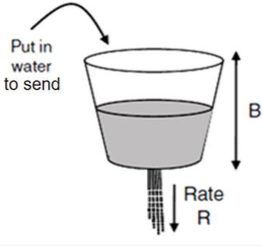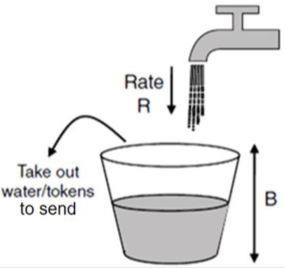Computer Networks
Table of Contents
Network: providing service
Congestion control Various approaches:
-
network provisioning — preventing by increasing available bandwidth (like widening a road)
-
traffic-aware routing — choose routes based on traffic, not just topology
-
admission control — if there’s congestion, new traffic has to wait (like planes at an airport)
-
traffic throttling — send messages back to indicate network congestion (e.g. special bits in IP packet, inform through TCP)
- end-to-end — destination sends choke signal, source receives it and slows down transmission
- link-by-link — destination sends choke signal, every router along the way slows down transmission
-
load shedding — choose partial failure over total failure (that’s a good life motto)
- easy to implement, but packet loss will likely happen due to congestion
- Random Early Detection (RED) — drop packets randomly if buffer space is almost full, send implicit signal to sender to hold their horses
On a scale of slower preventative to faster reactive:

Quality of service parameters of QoS:
- Bandwidth — max data rate, in bits per second (bps)
- Delay — time it takes from source to destination (sec)
- Jitter — variation in packet delay (constant delay is 0)
- Packet loss — probability of packets being dropped
To guarantee QoS (or at least try), you need to control the traffic through:
- controlling data rate
- packet scheduling
- admission control
Traffic shaping regulates rate and burstiness of data entering the network:
- Leaky bucket — sending rate is ≤R, max queue size is B:

- Token bucket — limit average rate to R, limit short-term bursts up to B

Internetworking sending packets over multiple networks that use their own protocols
Tunnelling
-
if source and destination use same protocols
-
e.g. if host in Paris wants to send an IPv6 packet to an IPv6 host in London over the IPv4 internet, the IPv6 packet can be encapsulated inside of an IPv4 packet.
-
or, if a car that can drive on a road is transport as freight from one road to another using a train

Packet fragmentation each network puts a maximum size on packets size can be limited by hardware/software/protocols/law/… e.g. max payload for
-
802.3 - 1500 B
-
802.11 - 2272 B
-
IP - 65,515 B
- Transparent — packets are reassembled at every router

- Nontransparent — packets are reassembled only at final destination (host), this is what IP uses

- path MTU (max transmission unit) discovery
- each IP packet is sent with header bits disallowing fragmentation
- if a router receives a packet that’s too large, it drops it and sends back an error packet with required size.
- source then uses info inside error packet to refragment the original packet into smaller pieces
